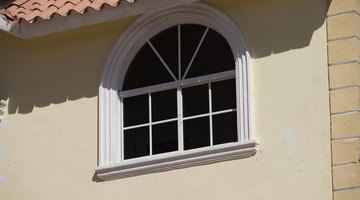What Is Elastomeric Stucco?
While unfinished stucco can have a life expectancy of up to 100 years if properly installed and cared for, an exterior coating of acrylic latex elastomeric paint will add additional strength and resistance to weathering and damage.

The coating stretches as the stucco masonry cracks – as it does even under normal circumstances – and bridges the cracks, preventing moisture and wind from further damaging the wall.
Basics
Masonry constructions, such as stucco, expand and contract with changing temperatures. Stucco, in particular, is also susceptible to retaining moisture, which can cause the stucco to crumble unless proper drainage is provided. Without proper maintenance and vigilance about the appearance of cracks or leaks, stucco can eventually become unstable and potentially affect the structural integrity of your home or building. Elastomeric coatings, applied in thick layers, prevent external moisture from getting into stucco and provide a flexible bridge for cracks that occur with expansion and contraction. In addition, elastomeric wall coatings are dirt-resistant and easy to clean. If tinted, the coating has better color retention that normal house paint, requiring fewer touch-ups.
Prepararion
Proper preparation of the stucco is necessary to get good adhesion between the coating and the stucco’s surface. Stucco should be brushed to remove dirt, and then power washed and dried. An application of 3 parts bleach to 1 part water will kill any mold or mildew on the stucco. Rinse off bleach well before continuing. Any existing cracks in the stucco larger than 1/16 inch should be sealed using acrylic or siliconized caulk. Allow the caulk to dry and cure as directed by the manufacturer.
Application
The Paint Quality Institute recommends purchasing one gallon of elastomeric coating for every 50 square feet of stucco. Use a long nap roller or sprayer to apply two thick layers of the coating. In the case of elastomeric coatings, the Paint Quality Institute also warns that consumers get what they pay for; top-quality, higher-priced coatings will last longer and retain their flexibility for a longer period of time than cheaper ones.
Maintenance
As proper initial application of the stucco will itself prolong its life, so will proper application of the initial layers of elastomeric coating. If blistering or tears occur, remove the damaged area of coating using a utility blade and putty knife, seal the edges around the damaged area with acrylic or siliconized caulk, apply a clean masonry sealer over the entire damaged area, and then recoat using fresh elastomeric coating. Use a wide brush or a putty knife to feather the edges of the repair onto the surrounding coating and allow the repair to dry.
References
Writer Bio
A writer and professional lab assistant based in Seattle, Kate Bruscke has been writing professionally about health care and technology since 1998. Her freelance clients include "The Seattle Times," KGB.com, Reading Local: Seattle, Nordstrom and MSN/Microsoft. Bruscke holds a Master of Fine Arts from The School of the Art Institute of Chicago.
Photo Credits
- Photos.com/Photos.com/Getty Images
- Photos.com/Photos.com/Getty Images
More Articles



